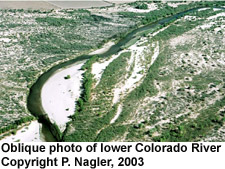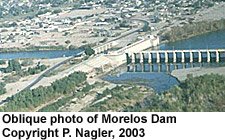
community | data | history | publication list | partners
Brief Intoduction
El Niño
Habitats
Legal Issues
People
More on legal issues
References
Full Report
|
Colorado
River Delta Institutions Institutions have supplanted precipitation in
determining the flows of the Colorado River, explaining the current
state of the river's delta. Institutions determine the manner The flows of the Colorado River below Hoover
Dam are controlled and regulated based on flood control requirements,
downstream diversion orders, and demands for hydroelectric power
(cf. Nathanson 1980). The degree of institutional control over the
Colorado River can not be overstated: the 1983 flood has been the
only instance since the construction of Hoover Dam in 1935 when
discharge from the dam, and along the lower Colorado River, was
not completely controlled by the Bureau of Reclamation (Holburt
1984). The concept of a major river whose flow can be turned on
and off is difficult to comprehend, but it is the central fact of
the lower Colorado River. Except in extremely rare instances of
unusually high inflows to Lake Mead and limited storage availability
(triggering U.S. Army Corps of Engineers Flood Control Release Guidelines),
the flows in the lower Colorado River are released by the U.S. Bureau
of Reclamation. The Bureau of Reclamation determines release rates
based on a complex algorithm to meet the downstream beneficial consumptive
use orders for agricultural diversions and municipal and industrial
diversions. |
 in
which water is allocated, the uses to which it may be applied, and
who may participate in allocative processes. Fradkin (1981:xviii)
writes, "To me the [Colorado] river, in
its present state, is primarily a product of the political process
. . . rather than a natural phenomenon." Institutions can be
described as the 'rules of the game,' the socially-devised constraints
to people's interactions with the environment and with each other
(Cortner et al. 1996).
in
which water is allocated, the uses to which it may be applied, and
who may participate in allocative processes. Fradkin (1981:xviii)
writes, "To me the [Colorado] river, in
its present state, is primarily a product of the political process
. . . rather than a natural phenomenon." Institutions can be
described as the 'rules of the game,' the socially-devised constraints
to people's interactions with the environment and with each other
(Cortner et al. 1996). This
algorithm integrates agricultural diversion orders, required deliveries
to Mexico, storage requirements, flood control, and hydroelectric
power generation contracts. The determination of releases takes
into consideration the priorities of water use as required by applicable
federal law. Instream flows through the riparian corridor of Colorado
River delta are almost entirely dependent on releases from upstream
dams.
This
algorithm integrates agricultural diversion orders, required deliveries
to Mexico, storage requirements, flood control, and hydroelectric
power generation contracts. The determination of releases takes
into consideration the priorities of water use as required by applicable
federal law. Instream flows through the riparian corridor of Colorado
River delta are almost entirely dependent on releases from upstream
dams.